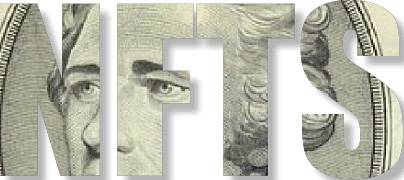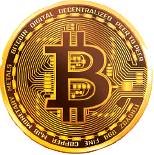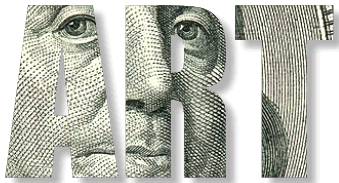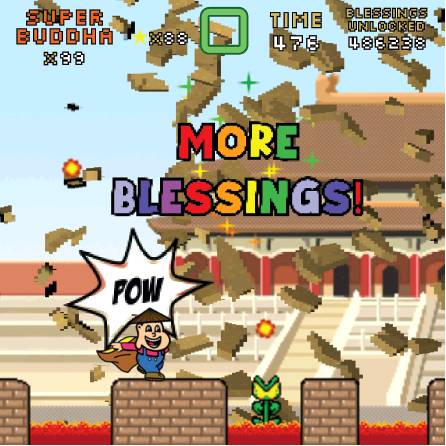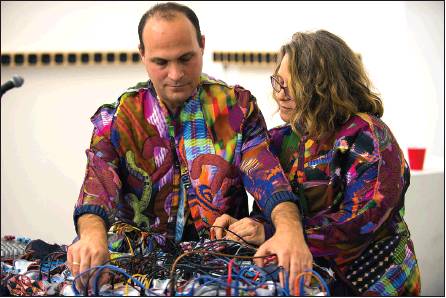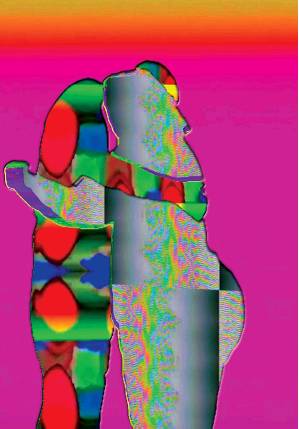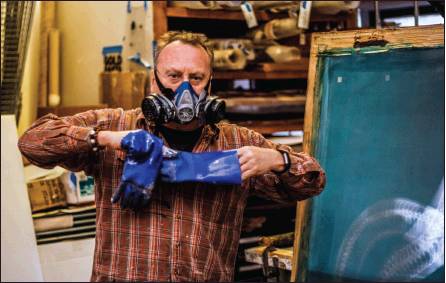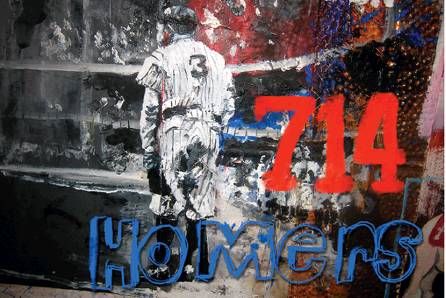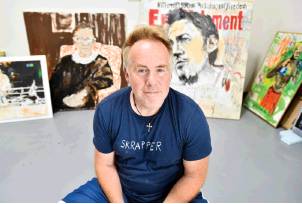MARKETS AND ARTISTS ARE DIGGING IT
NFTS ARE SHAKING UP LOCAL AND GLOBAL ART
BY SOPHIE GRIFFIN
hat’s the value of a piece of art? Why do people want, buy, or collect art? Should artwork be treated like assets, subject to the economic laws of supply and demand? While these have been questions ever since people started buying art, a new technology has catalyzed renewed interest in them: NFTs, or non-fungible tokens. Created in 2014 by Kevin McCoy and Anil Dash in a live demonstration at the “Seven on Seven” conference, NFTs have exploded in popularity in 2021. NFT speculation, linked to rapid growth in cryptocurrency, is now a multibillion-dollar market. And they’re shaking up the art world, too: a mosaic of pieces called “Everydays: The First 5000 Days,” by the digital artist Beeple was sold at auction by Christie’s for over $69 million. That sale made the work the third most expensive piece ever sold by a living artist and brought lots of attention to NFTs. Now, East End artists, galleries and dealers are entering the market. First, a basic breakdown of what an NFT is. Non-fungible means the item is unique and non-interchangeable. For illustration, a twenty-dollar bill is fungible: you can turn it into two tens, four fives, or 2,000 pennies and it still has the same value. NFTs can’t do that. You can buy and sell NFTs, but each is completely one-of-a-kind. (Sometimes many of the same image or file are sold as NFTs, like editions of a print, but each individual one still has a unique digital signature). They can be anything that can exist online: a song, an image, or even a fart. They’re popular in the worlds of video games and professional sports — in the latter, NBA highlight clips of Lebron James have sold for over $200,000.
“Token” means that it’s a file that sits in a digital ledger called blockchain, with a unique digital address. This provides proof of ownership for whoever buys the NFT. (It also makes them subject to link rot because NFTs aren’t embedded in the code, the address to access them is, and if a company folds or a link changes, they can be lost.) Blockchain is a public, decentralized ledger made up of bits of code used to record transactions that’s constantly updated by a network of computers around the world. Blockchain is what cryptocurrencies like Bitcoin run on. Make sense? If not, you’re not alone. Confusion about NFTs has grown almost as fast as the market for them has.
Some herald NFTs as a revolution that will give more power to artists, decentralize the exclusive art world, and change the way we look at art. NFTs can be great for artists: what is essentially a royalty is built into them, so every time the art is resold, the original artist gets a cut, usually about 10 percent. Collectors who buy NFTs don’t just get bragging rights and an asset, they’re also directly supporting a creator. Additionally, the open marketplaces mean that theoretically, every artist has an equal chance at reaching an audience. NFT transactions are more transparent, as long as you aren’t buying from a shady marketplace, and offer a means of ownership outside copyright. And, since they’re digital, they take up no physical space and don’t need to be stored, shipped, or taken care of.
For critics, NFTs are an overhyped climate nightmare that is over commercializing the already-commercialized world of art. Anil Dash, who co-made the first NFT, wrote an “Atlantic” article called “NFTs Weren’t Supposed to End Like This” decrying the state of the tech. Some people find NFT art ugly or bad. Others can’t wrap their heads around owning artwork that you can’t hang on a wall or hold in your hands. And for NFTs like NBA TopShots, clips of games, or popular memes, like Nyan Cat, it seems a bit silly to fork over a fortune when anyone in the world can download the file, too. But NFT buyers tend to look at their collections differently, and may see them as a portfolio of assets, like stocks, that will most likely grow in value as cryptocurrency becomes more lucrative. And for the extremely-online, physical art can be more of a burden than it’s worth.
‘What changes [for NFTs] is the playing field, the creativity behind it. Right now, it’s not only a paintbrush to a cotton canvas. Now it’s a whole realm of possibilities on this metaphysical world that you could just create anything, way past something you could do on a canvas.’
- SUPER BUDDHA
NFTs, like crypto, have spawned a world unto themselves, populated by digital evangelists who have their own lexicon and unique aesthetic. NFT avatars — digital skins, essentially — are displayed with pride. Even Jay-Z bought a CryptoPunk and made it his Twitter profile pic. Many devotees spend hours on Discord or Clubhouse with other NFT and crypto-heads, creating digital communities around their shared interest.
Despite their digital, non-physical nature, NFTs don’t just exist in the blockchain ether — they’re also coming to the East End in a big way, especially for fine art. As galleries, arts organizations, and collectors have moved eastward in the past year, NFTs have come along for the ride. Both local and global artists are dipping their toes into the ocean of NFTs.
At Kathryn Markel Fine Arts in Bridgehampton, the first group show of NFT art is going up August 12, marking what is most likely the Hamptons’ first-ever NFT exhibition. Featuring the work of six artists, including Steve Miller, and titled “Re-Merge,” the exhibit will feature an NFT art projection and the launch of Ultra Art, a curated platform for NFT art. Part of the proceeds from the exhibition will go to benefit Guild Hall to honor its 90th year.
At the Market Art + Design fair, hosted at the Bridgehampton Museum from August 12 to 15, Lisa Burgess, president of South Florida’s New River Fine Art gallery, will be displaying three exclusive NFTs created by artist Super Buddha.
“When it became very, very, clear that in order to stay relevant, we were going to have to venture into this brave new world, he was the first person I called,” Burgess said of Super Buddha.
Born in Venezuela but raised in China, Super Buddha makes art informed by graffiti, old-school video games, and anime. Many of his pieces feature a minimalist, chubby-cheeked figure called the Chosen One. The offerings this August will be his first serious foray into NFTs, and the first for Burgess Modern and Contemporary as well. Burgess hopes that they will help collectors understand how to display NFTs and how they can be lived with. Both Super Buddha and Burgess believe that NFTs will continue to grow and offer exciting opportunities for artists.
“It opens up a whole new aspect of creativity and a whole new dimension of creativity for artists,” Burgess said.
Super Buddha explained that he wanted to make work focusing on retro video games for his first NFT offering because those games were the first time many people stepped into a virtual world.
“What changes [for NFTs] is the playing field, the creativity behind it. Right now, it’s not only a paintbrush to a cotton canvas. Now it’s a whole realm of possibilities on this metaphysical world that you could just create anything, way past something you could do on a canvas. Because you have motion, you have a longer time span of engagement with the art. It’s not just a still picture anymore,” Super Buddha explained.
‘I feel like artists always rise to the challenge and do weird stuff, but if it’s super market-driven, like let’s just sell our memes and you just make meme art to make money, I don’t know. As long as the arts can resist it and can be like, okay, that’s fine for pop culture, etc. and we want to do other things, and it doesn’t dry the resources then it’s fine.’
- TALI HINKIS
Tali Hinkis, a Long Island-based artist, has been making digital artwork for a long time as part of LoVid, a collaboration with her husband, Kyle Lapidus. Recently, she’s started creating NFTs, but instead of going through the open market on a website like Rarible or OpenSea, she sells hers through Postmasters Blockchain, the NFT extension of the Postmasters Gallery. Her first NFT work was born out of the pandemic. She collected videos of friends and family who she was unable to physically see because of the virus, and animated them.
Hinkis originally heard about NFTs years ago, from Kevin McCoy, who made the first one back in 2014 and launched the platform Monegraph with his wife, Jennifer. Back then, Hinkis, like many, didn’t really understand what they were. But over time, as NFTs became a larger force, she became more interested.
“I’ve been involved in the art world and the media/digital art world for 20 years or so. I have this position of following, educating myself, getting a real solid grasp on it, seeing what I can do to be involved, following the conversation. [NFTs] felt and still do, like such a change, such a radical change, that is unavoidable and you really have to just pay attention to and think about kind of like the way the internet came, you know, in the nineties,” Hinkis said.
Hinkis described some of her concerns about NFTs: questions about what collectors actually get or own, in terms of usage rights or copyright, the environmental impact, and the influence of the market itself on artistic expression.
“Putting everyone in the same category, meaning artists who work within the existing art world or the experimental art world together in the same category with designers and pop culture and sports NFTs, I don’t know if in the long run that’s good for art or bad for art... I do wonder if [NFTs] are going to distort people’s ideas of what digital art is and make less room for real experimental, really critical and intellectually-driven artwork,” she said.
“I feel like artists always rise to the challenge and do weird stuff, but if it’s super market-driven, like let’s just sell our memes and you just make meme art to make money, I don’t know. As long as the arts can resist it and can be like, okay, that’s fine for pop culture, etc. and we want to do other things, and it doesn’t dry the resources then it’s fine,” Hinkis continued.
At the AB NY Gallery, based in East Hampton and New York, founder and artist William Quigley sold out his first NFT in under a minute. In collaboration with Seth Lamburn (aka Skrapper Punk) and Wax Wallet, Quigley sold a digital version of his painting of Babe Ruth, and more drops are coming in early August.
‘If you’re a flat artist and you don’t know these computer programs, you’ll hook up with an animator, and a musician and the three of you split the duties and the profits, but the three of you start to create this sort of new hybrid that only exists as a digital file.’
- STEVE MILLER
“It’s just a new way to look at art that’s revolutionizing art history... There are some great works being done. And like most great art, we may not recognize its significance until years from now. NFT’s literally are putting the word POP of originality into art again for the first time since Warhol,” Quigley wrote.
Sarah Scribner, director of the gallery, has also been involved in the intersection of art, finance, and tech, and believes NFTs will be a long-standing commodity.
“Given we have looked at so much art online in the last year our way of seeing has developed to a great appreciation of the medium. … I think it is important for the longevity of both the blockchain based art market and the traditional art market that inventory does not exceed demand. I think there will always be paintings that will best exist on your wall and digital art which will reach new audiences through this technology,” she wrote.
Steve Miller, a Bridgehampton-based artist, has always worked at the cutting-edge of art and technology. He heard about NFTs early and started minting them on Foundation this year. His NFT artworks are slow-mo videos grounded in his studio practice: even as pieces of the blockchain, they remain grounded to the physical production of art.
“I realized that NFT was just a radical departure from what traditionalists think about as fine art. And there was a whole other aesthetic, which at the time I did not understand. When I started getting on Clubhouse and talking to the whales [individuals who hold large amounts of coins of a certain cryptocurrency] and the CryptoPunks, it became really clear that there’s a different way of thinking about imagery and about culture,” Miller said.
Miller explained that NFTs cannot only foster community on platforms like Clubhouse, but also collaboration between artists of different disciplines.
“If you’re a flat artist and you don’t know these computer programs, you’ll hook up with an animator, and a musician and the three of you split the duties and the profits, but the three of you start to create this sort of new hybrid that only exists as a digital file,” he said.
Although the technology that undergirds NFTs is quite recent, artists have been experi-
EXPRESS MAGAZINE | AUGUST 2021
menting with non-traditional ways of artmaking for many years.
“[Yves Klein] did a piece in the sixties where he threw gold leaf into the Seine and he documented it with a photograph. The collector got a document that says eight grams, or whatever amount, of gold leaf is in the Seine. So to put this kind of conceptual art on the blockchain makes so much sense,” Miller said.
Miller also described the work of Sol LeWitt, the American minimalist artist. When someone bought one of his famous wall drawings, they would receive a certificate with detailed instructions for reproducing the painting. Anyone with the instructions could have their own Sol LeWitt piece, even after the artist himself passed away.
The one thing about art that stays the same is that it’s always changing, always evolving. As NFTs alter the marketplace for art and the way art works, who can say what kinds of expression will come out of it. But whether you love them or hate them, their impact can’t be ignored.
37
‘It’s just a new way to look at art that’s revolutionizing art history... There are some great works being done.’
- WILLIAM QUIGLEY
